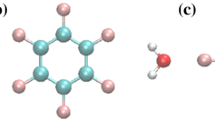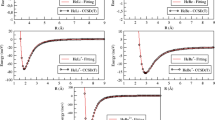Abstract
The formation of (HF)n aggregates with n = 2, 3, 4, 5 and 6 and concerted proton transfer processes in these aggregates were systematically analyzed. It was verified that, by a cooperative effect, the barrier associated with the proton transfer process decreases for aggregates with a larger number of molecules, indicating that the activation energy for proton transfer depends on the molecularity of the process. Natural bond orbital and quantum theory of atoms in molecules were used to characterize the strength of the hydrogen bonds established in the aggregates, which verified a general increase in the delocalization energy as a function of increasing aggregate size. A deformed Eyring (d-Eyring) equation was used to calculate the proton transfer rate constants, where the d-Eyring equation adequately described the proton transfer kinetics. Analysis of the rate constants showed that proton transfer became faster as the cluster size increased. Arrhenius and d-Arrhenius plots showed a decrease in the dependence of the rate constants on temperature, particularly for the tetramer, pentamer, and hexamer. The d-Arrhenius plots, for which the d parameter was included in the Eyring equation, suggest non-Arrhenius behavior for proton transfer in the HF aggregates at low temperatures.







Similar content being viewed by others
References
Atoji M, Lipscomb WN (1954) The crystal structure of hydrogen fluoride. Acta Crystallogr 7:173–175
Hunt SW, Higgins KJ, Craddock MB et al (2003) Influence of a polar near-neighbor on incipient proton transfer in a strongly hydrogen bonded complex. J Am Chem Soc 125:13850–13860. https://doi.org/10.1021/ja030435x
Kuśmierczuk W, Witkowski A (1981) Infrared spectra of hydrogen-bonded hydrogen halides. Chem Phys Lett 81:558–559. https://doi.org/10.1016/0009-2614(81)80462-9
Loerting T, Liedl KR, Rode BM (1998) Large curvature tunneling effects reveal concerted hydrogen exchange rates in cyclic hydrogen fluoride clusters comparable to carboxylic acid dimers. J Am Chem Soc 120:404–412. https://doi.org/10.1021/ja972799t
Quack M, Schmitt U, Suhm MA (1997) FTIR spectroscopy of hydrogen fluoride clusters in synchronously pulsed supersonic jets Isotopic isolation, substitution and 3-d condensation. Chem Phys Lett 269:29–38. https://doi.org/10.1016/S0009-2614(97)00203-0
Roohi H, Taghezadeh R (2011) Intra-cluster proton transfer in anilide–(HF)n (n = 1–4): Can the size of HF cluster influence the N − ···H–F → N–H···F − switching. J Fluor Chem 132:459–467. https://doi.org/10.1016/j.jfluchem.2011.04.018
de Giambiagi MS, de Neto MO, de Neder AVF (2005) Cooperative effect of CH···O bonds in models for biological systems. J Math Chem 38:519–532. https://doi.org/10.1007/s10910-005-6905-3
Io A, Kawatsu T, Tachikawa M (2019) Quantum stabilization of the frustrated hydrogen bonding structure in the hydrogen fluoride trimer. J Phys Chem A 123:7950–7955. https://doi.org/10.1021/acs.jpca.9b04407
Quack M, Schmitt U, Suhm MA (1993) Evidence for the (HF) 5 complex in the HF stretching FTIR absorption spectra of pulsed and continuous supersonic jet expansions of hydrogen fluoride. Chem Phys Lett 208:446–452. https://doi.org/10.1016/0009-2614(93)87171-X
Morais SF de A, Mundim KC, Ferreira DAC (2015) An alternative interpretation of the ultracold methylhydroxycarbene rearrangement mechanism: cooperative effects. Phys Chem Chem Phys 17:7443–7448. https://doi.org/10.1039/C4CP05842A
Frisch MJ, Head-Gordon M, Pople JA (1990) A direct MP2 gradient method. Chem Phys Lett 166:275–280. https://doi.org/10.1016/0009-2614(90)80029-D
Frisch MJ, Head-Gordon M, Pople JA (1990) Semi-direct algorithms for the MP2 energy and gradient. Chem Phys Lett 166:281–289. https://doi.org/10.1016/0009-2614(90)80030-H
Head-Gordon M, Head-Gordon T (1994) Analytic MP2 frequencies without fifth-order storage. Theory and application to bifurcated hydrogen bonds in the water hexamer. Chem Phys Lett 220:122–128. https://doi.org/10.1016/0009-2614(94)00116-2
Weigend F (2006) Accurate Coulomb-fitting basis sets for H to Rn. Phys Chem Chem Phys 8:1057–1065. https://doi.org/10.1039/B515623H
Weigend F, Ahlrichs R (2005) Balanced basis sets of split valence, triple zeta valence and quadruple zeta valence quality for H to Rn: Design and assessment of accuracy. Phys Chem Chem Phys 7:3297–3305. https://doi.org/10.1039/B508541A
Schlegel HB (1982) Optimization of equilibrium geometries and transition structures. J Comput Chem 3:214–218. https://doi.org/10.1002/jcc.540030212
Bader RFW (1991) A quantum theory of molecular structure and its applications. Chem Rev 91:893–928. https://doi.org/10.1021/cr00005a013
Bader RFW (1994) Atoms in molecules: a quantum theory. Clarendon Press, Oxford
Reed AE, Curtiss LA, Weinhold F (1988) Intermolecular interactions from a natural bond orbital, donor-acceptor viewpoint. Chem Rev 88:899–926. https://doi.org/10.1021/cr00088a005
Reed AE, Weinhold F (1985) Natural localized molecular orbitals. J Chem Phys 83:1736–1740. https://doi.org/10.1063/1.449360
Reed AE, Weinstock RB, Weinhold F (1985) Natural population analysis. J Chem Phys 83:735–746. https://doi.org/10.1063/1.449486
Chai J-D, Head-Gordon M (2008) Long-range corrected hybrid density functionals with damped atom–atom dispersion corrections. Phys Chem Chem Phys 10:6615–6620. https://doi.org/10.1039/B810189B
Dunning TH (1989) Gaussian basis sets for use in correlated molecular calculations. I. The atoms boron through neon and hydrogen. J Chem Phys 90:1007–1023. https://doi.org/10.1063/1.456153
Kendall RA, Dunning TH, Harrison RJ (1992) Electron affinities of the first-row atoms revisited. Systematic basis sets and wave functions. J Chem Phys 96:6796–6806. https://doi.org/10.1063/1.462569
Frisch MJ, Trucks GW, Schlegel HB et al (2009) Gaussian 09, Revision B.01. Gaussian 09, Revis. B.01, Gaussian, Inc., Wallingford CT
Keith TA (2017) AIMAll (Version 16.05.18)
Andrienko GA (2015) Chemcraft—graphical software for visualization of quantum chemistry computations. https://www.chemcraftprog.com
Eyring H (1935) The activated complex and the absolute rate of chemical reactions. Chem Rev 17:65–77. https://doi.org/10.1021/cr60056a006
Silva VHC, Aquilanti V, de Oliveira HCB, Mundim KC (2013) Uniform description of non-Arrhenius temperature dependence of reaction rates, and a heuristic criterion for quantum tunneling vs classical non-extensive distribution. Chem Phys Lett 590:201–207. https://doi.org/10.1016/j.cplett.2013.10.051
Tsallis C (1988) Possible generalization of Boltzmann–Gibbs statistics. J Stat Phys 52:479–487. https://doi.org/10.1007/BF01016429
Arrhenius S (1889) Über die Reaktionsgeschwindigkeit bei der Inversion von Rohrzucker durch Säuren. Zeitschrift für Phys Chemie 4U:226–248. https://doi.org/10.1515/zpch-1889-0416
Mulyava MT, Shevchuk VU (1967) Calculation of pre-exponential factors for radical substitution reactions on the basis of the additivity principle. Theor Exp Chem 1:482–485. https://doi.org/10.1007/BF00524032
Aquilanti V, Mundim KC, Elango M et al (2010) Temperature dependence of chemical and biophysical rate processes: phenomenological approach to deviations from Arrhenius law. Chem Phys Lett 498:209–213. https://doi.org/10.1016/j.cplett.2010.08.035
Aquilanti V, Borges EP, Coutinho ND et al (2018) From statistical thermodynamics to molecular kinetics: the change, the chance and the choice. Rend Lincei Sci Fis e Nat 29:787–802. https://doi.org/10.1007/s12210-018-0749-9
Contributors W Aquilanti–Mundim deformed Arrhenius model. In: Wikipedia, Free Encycl
Redington RL (1982) Nonideal-associated vapor analysis of hydrogen fluoride. J Phys Chem 86:552–560. https://doi.org/10.1021/j100393a027
Meier BH, Graf F, Ernst RR (1982) Structure and dynamics of intramolecular hydrogen bonds in carboxylic acid dimers: a solid state NMR study. J Chem Phys 76:767–774. https://doi.org/10.1063/1.443045
Acknowledgments
The authors acknowledge grants from the following Brazilian Institutions: CAPES, CNPQ, and UnB.
Author information
Authors and Affiliations
Corresponding authors
Additional information
Publisher's Note
Springer Nature remains neutral with regard to jurisdictional claims in published maps and institutional affiliations.
"Festschrift in honor of Prof. Fernando R. Ornellas" Guest Edited by Adélia Justino Aguiar Aquino, Antonio Gustavo Sampaio de Oliveira Filho and Francisco Bolivar Correto Machado.
Electronic supplementary material
Below is the link to the electronic supplementary material.
Rights and permissions
About this article
Cite this article
A. Morais, S.F., Mundim, K.C. & Ferreira, D.A.C. Non-conservation of activation energy barriers in the same chemical process: a cooperative (effect) proton transfer on (HF)n molecular aggregates. Theor Chem Acc 139, 164 (2020). https://doi.org/10.1007/s00214-020-02681-1
Received:
Accepted:
Published:
DOI: https://doi.org/10.1007/s00214-020-02681-1




